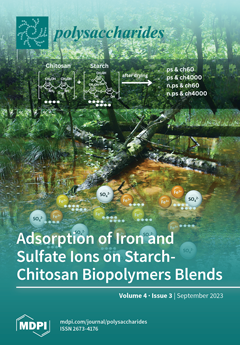Calorimetric (from both isothermal micro-calorimetry and DSC), chiro-optical, viscometric and rheological data on aqueous solutions of pectic acid and low-methoxyl pectin (LMP), published over decades from different laboratories, have been comparatively revisited. The aim was to arrive at a consistent and detailed description of the behavior of galacturonan as a function of pH, i.e., of the degree of charging (as degree of dissociation, α) of the polyanion. The previously hypothesized pH-induced transition from a 3
1 to a 2
1 helix was definitely confirmed, but it has been shown, for the first time, that the transition is always coupled with loosening/tightening effects brought about by an increase in charge. The latter property has a twofold effect: the former effect is a purely physical one (polyelectrolytic), which is always a loosening one. However, in the very low range of pH and before the beginning of the transition, an increase in charge tightens the 3
1 helix by strengthening an intramolecular—but inter-residue—hydrogen bond. The value of the enthalpy change of 3
1 → 2
1 transition—+0.59 kcal·mol
−1—is bracketed by those provided by theoretical modeling, namely +0.3 and +0.8 kcal·mol
−1; the corresponding entropy value is also positive: +1.84 cal·mole r.u.
−1·K
−1. The enthalpic and the entropic changes in chain loosening amount only to about 23% of the corresponding 3
1 → 2
1 changes, respectively. Much like poly(galacturonic acid), the 3
1 conformation of LMP also stiffens on passing from pH = 2.5 to 3.0, to then start loosening and transforming into the 2
1 one on passing to pH = 4.0. Lowering the pH of a salt-free aqueous solution of LMP down to 1.6 brings about a substantial chain–chain association, which is at the root of the interchain junctions stabilizing the acid pH gels, in full agreement with the rheological results. A comparison of the enthalpic data reveals that, at 85 °C, LMP in acidic pH conditions has lost its initial order by about 2.3 times more than pectic acid brought from low charging to full neutralization (at α = 1.0) at 25 °C. A proper combination of experiments (enthalpic measurements) and theory (counterion condensation polyelectrolyte theory) succeeded in demonstrating, for the first time ever, a lyotropic/Hofmeister effect of the anion perchlorate in stabilizing the more disordered form of the 2
1 helix of galacturonan. The viscometric results in water showed that the 3
1 helix is capable of forming longer rheologically cooperative units compared with the 2
1 helix. Extrapolation to infinite ionic strength confirmed that, once all electrostatic interactions are cancelled, the elongation of the two helical forms is practically the same. At the same time, however, they indicated that the flexibility of the two-fold helix is more than fifteen times larger than that of the three-fold one. The result is nicely corroborated by a critical revisiting of
23Na relaxation experiments.
Full article





